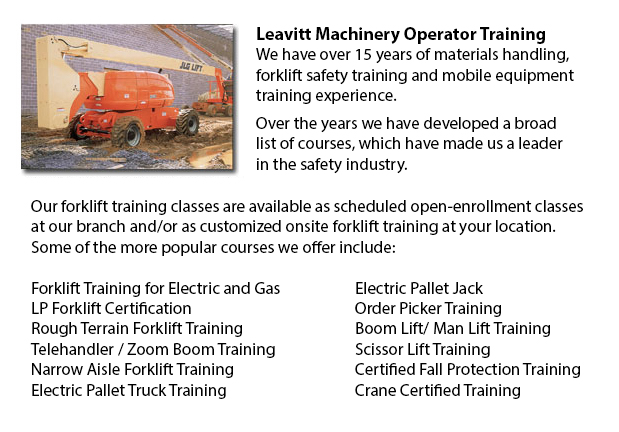
Nanaimo Boom Lift Certification - Using elevated work platforms allow for maintenance operations and work to be carried out at elevated work heights which were otherwise not reachable. Workers making use of scissor lifts and boom lifts can learn how to safely operate these machines by acquiring boom lift certification training.
When work platforms are not operated safely, they have the possibility for serious injury and even death, regardless of their lift style, application or the site conditions. Electrocution, falls, tip-overs and crushed body parts could be the unfortunate outcome of wrong operating procedures.
To prevent aerial lift incidents, people have to be qualified to train workers in operating the certain kind of aerial lift they would be utilizing. Controls should be easily accessible in or beside the platform of boom lifts made use of for carrying workers. Aerial lifts must never be modified without the express permission of other recognized entity or the manufacturer. If you are leasing a lift, make certain that it is properly maintained. Before utilizing, controls and safety devices should be inspected to be able to ensure they are functioning correctly.
Operational safety procedures are essential in avoiding incidents. Operators must not drive an aerial lift with the lift extended (although a few are designed to be driven with an extended lift). Set outriggers, if available. Always set brakes. Avoid slopes, but when necessary use wheel chocks on slopes which do not go over the manufacturer's slope limits. Adhere to manufacturer's load and weight restrictions. When standing on the boom lift's platform, utilize a safety belt with a two-foot lanyard tied to the boom or basket or a full-body harness. Fall protection is not needed for scissor lifts which have guardrails. Do not climb or sit on guardrails.
This course features the following topics: safety tips to prevent a tip-over; training and certification; surface conditions and slopes; inspecting the travel path & work area; stability factors; other tips for maintaining stability; weight capacity; leverage; testing control functions; pre-operational inspection; safe operating practices; mounting a motor vehicle; overhead obstacles and power lines; safe driving procedures; use of lanyards and harness; PPE and fall protection; and avoiding falls from the platform.
The successful trainee will learn the following: training and authorization procedures; pre-operational check procedures; how to avoid tip-overs; factors affecting the stability of boom and scissor lifts; how to use PPE, how to utilize the testing control functions and strategies in order to prevent falls.
-
Nanaimo Boom Lift Safety Training
Nanaimo Boom Lift Safey Training - Boom lifts are a kind of aerial lifting device or elevated work platform which are commonly used in industry, warehousing and construction. Boom lifts could be utilized in practically whichever environment because o... More -
Nanaimo Loader Operator Training
Nanaimo Loader Operator Training - Loader Operator Training - Forklift training is a prerequisite within North America and is intended to prevent workplace death and injuries. Lift truck training provides driver training intended for forklift operato... More -
Fall Protection Certification in Nanaimo
There are high numbers of injuries at work associated to falling and lots of fall-related deaths reported each and every year. Most of these instances might have been prevented with better training, better measures in place, and by properly equipping... More -
Nanaimo Crane Ticket
Nanaimo Crane Ticket - The modern version of a crane can be either complex or simple, and cranes vary based on their use. Mobile cranes, for example are rather simple. A telescopic boom or steel truss mounts its movable platform. A system of levers o... More -
Operator Safety Certification | Re-Qualification Certification | In-House Instructor Certification in Nanaimo
Lift trucks are used in practically all industrial construction sites and in warehouse operations and in boat yards. The reach feature of a forklift is a very important part utilized in several applications like when a shelving system is being used t... More -
Aerial Lift / Boom Lift / Man Lift / Scissor Lift Certification in Nanaimo
Scissor hoists are lift tables which lift up materials and individuals and supplies vertically. They are normally used in construction, commercial and industrial environments. A common use of scissor hoists is for lowering or lifting construction sup... More -
Crane / Overhead Crane / Self-Erect Crane / Truck Mounted Crane / Hydraulic Cranes Certification in Nanaimo
Bridge cranes or likewise called overhead cranes are a type of industrial material handling crane utilizing a line and hook apparatus that runs on a horizontal beam running along two widely separated rails. Several overhead cranes can be seen inside... More -
Nanaimo Warehouse Forklift Safety Training
Nanaimo Warehouse Forklift Safety Training - The business will face claims for liability when injuries and damage are sustained in an accident at the workplace. Warehouses could be a dangerous place to work for its employees, making employee safety a... More

Forklift Certification Nanaimo
TOLL FREE: 1-888-254-6157
Nanaimo, British Columbia
forkliftcertificationnanaimo.com
Email Us
About Us


